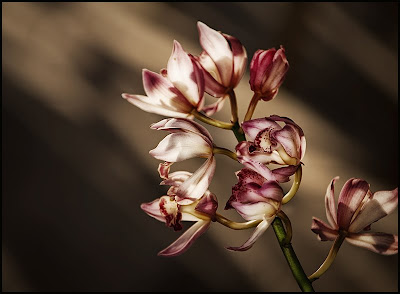
JD has some beautiful orchids around the house right now. This one is on our screened-in back porch. I like the colors, the flow and the textures of these orchids, but every time I have tried to photograph them, I did not like my results.
On Sunday, I tried a new approach. I wanted the photograph to be more dramatic with a surreal look. I wanted to create more flow within the image. I thought that I could create more flow through how I lit the scene.
I places a Nikon SB800 outside of our screened-in porch and shot through some lattice work in order to create some shadows on the floor. Next, I placed a SB800 with a snoot and pointed at the back of the flowers. I wanted this flash to provide some separation from the background and to make the flowers look more translucent. And finally, I used a SB800 with a small softbox attached to light the flowers from the front. I triggered everything using the commander unit in the Nikon D700. I played with the lighting ratios until I got them to where I wanted.
After taking several shots, I decided that I wanted the lighting pattern on the floor to be more blurred but I could not change my aperture because I need the aperture I was using in order to get most of the flowers in focus. I moved the orchids to the top of a small step latter (thereby increasing the flowers' distance from the floor) and shot from the top of a larger step latter--thus I was able to keep my shooting angle (and the lighting pattern on the floor) and the depth of field that I needed for the flowers, but added blur to my background.
I am still not completely happy with my final shot, but, I am getting there. I have a couple of more ideas about how to shoot this one, so you might see these flowers again in the near future.
Enjoy.
Camera Setting: Nikon D700, 70-200mm f/2.8 at 200mm, ISO 200, f/11 at 1/60th of a second with three NIkon SB800 speedlight triggered by Nikon CLS.
Post Processing: Lightroom and Photoshop--set white and black point, adjusted white balance, used nik Color Efex Pro tonal contrast and glamour glow filters and sharpened the flowers using the high pass filter in soft light mode.
After completing my post processing, I flipped the image so that I had the lighting pattern running from top left to bottom right as Craig Tanner recently suggested in a couple of his daily critiques. I was quite surprised at the difference it made. It made the overall flow of the image more pleasant and less strained as I was looking at it. What do you think?
















